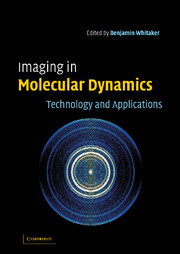Book contents
- Frontmatter
- Contents
- List of contributors
- Preface and acknowledgements
- List of abbreviations
- Part 1 Technology
- Part 2 Applications
- 8 Kinematically complete imaging of molecular many-body fragmentation: coincident multi-particle detection and analysis
- 9 Collisions of HCl with molecular colliders at ~ 540 cm-1 collision energy
- 10 Measurement of state-resolved differential cross-sections of bimolecular reactions using single beam velocity mapping
- 11 Slice imaging: a new approach to ion imaging and velocity mapping
- Index
10 - Measurement of state-resolved differential cross-sections of bimolecular reactions using single beam velocity mapping
Published online by Cambridge University Press: 07 August 2009
- Frontmatter
- Contents
- List of contributors
- Preface and acknowledgements
- List of abbreviations
- Part 1 Technology
- Part 2 Applications
- 8 Kinematically complete imaging of molecular many-body fragmentation: coincident multi-particle detection and analysis
- 9 Collisions of HCl with molecular colliders at ~ 540 cm-1 collision energy
- 10 Measurement of state-resolved differential cross-sections of bimolecular reactions using single beam velocity mapping
- 11 Slice imaging: a new approach to ion imaging and velocity mapping
- Index
Summary
Introduction
The dynamics of chemical reactions can be probed in detail by employing a method of experimentation that is sensitive to both reactant and product internal state energy distributions and velocities and correlations between these quantities. Two main scattering techniques have emerged to study bimolecular reactions of the form A+BC → AB+C.
One is the crossed molecular beam technique [1], in which molecular beams of the reactants A and BC, with well-defined beam velocities, are intersected at some angle. The AB and/or C product velocity and angular distributions are then measured with a form of universal ionization (such as electron impact ionization) and time-of-flight mass spectrometry (TOF–MS). The universal ionization step is used because the product densities are usually too small to allow a form of state selection, such as that of laser ionization, which provides small detection volumes.
Another method is a single beam technique [2,3], in which reactants or their precursors are premixed and co-expanded through a pulsed nozzle thus forming a single molecular beam. A photolysis laser is used to generate hot-atom reactants that subsequently react with other molecules in the beam. After a suitable time delay (typically 50–500 ns) that allows a sufficient density of products to build up, a second (probe) laser is used to state-selectively probe the reaction products, which are then detected with a velocity-sensitive technique (either TOF–MS, or Doppler spectrometry).
- Type
- Chapter
- Information
- Imaging in Molecular DynamicsTechnology and Applications, pp. 217 - 226Publisher: Cambridge University PressPrint publication year: 2003
- 1
- Cited by



